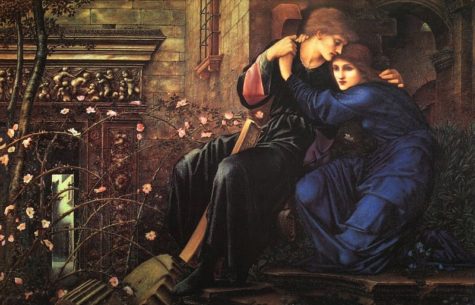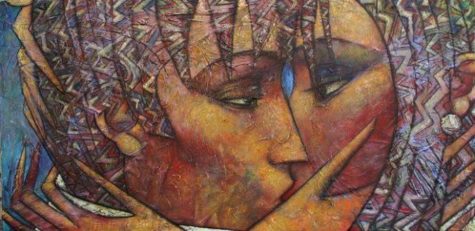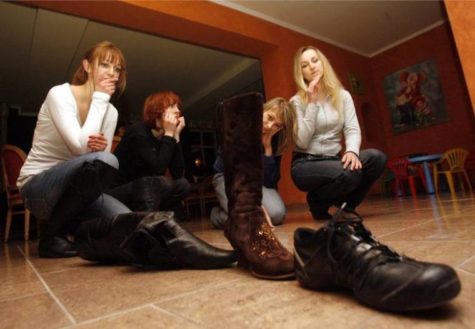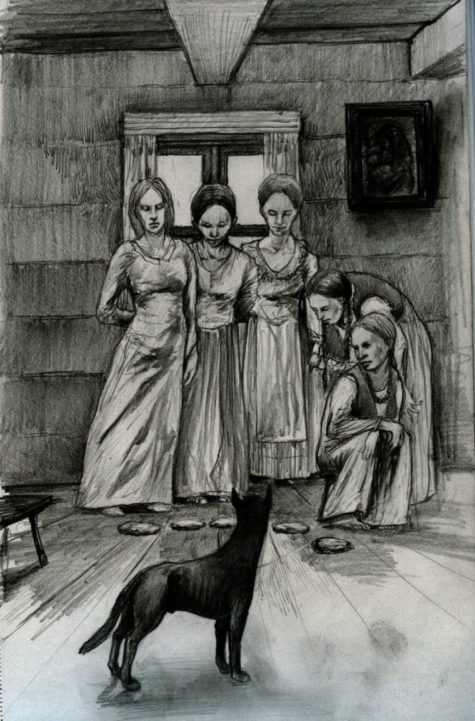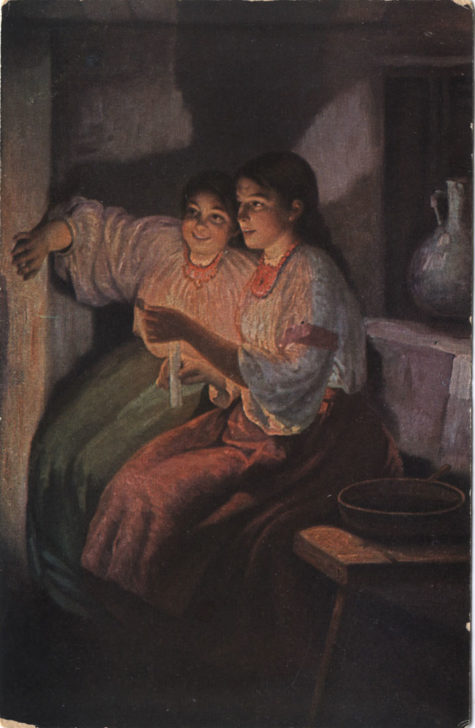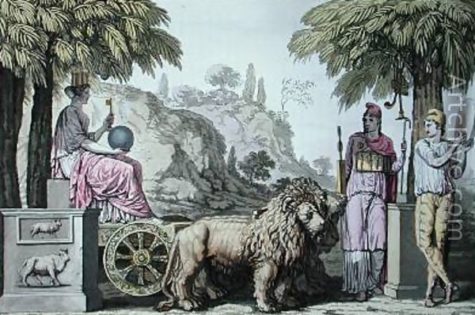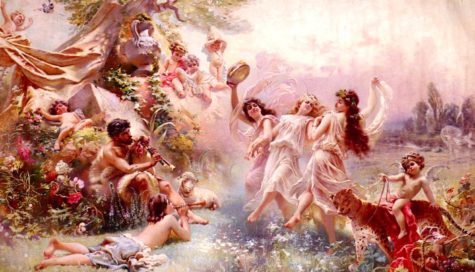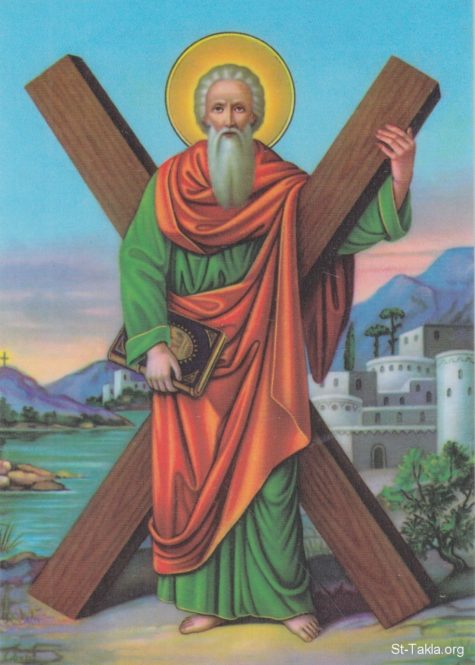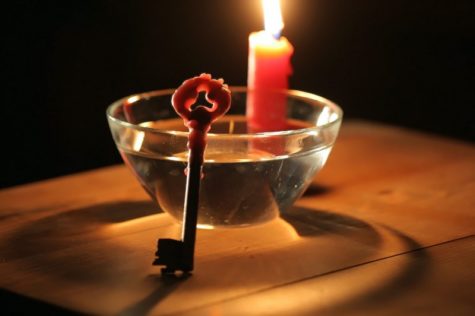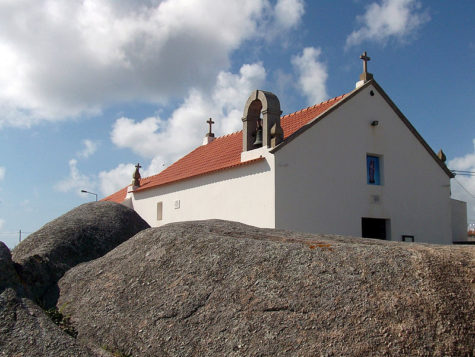Divination
January 21 is the Eve of St Agnes. There are many traditions associated with both this night and tomorrow night, all intended to bring dreams of the future husband. Here are some of them.
- Walking thrice backwards around a churchyard in silence at midnight, scattering hemp seed over the left shoulder.
- Boiling an egg, removing the yolk and filling the center with salt and then eating the whole, shell included!
- Sticking 9 pins into a red onion, taking it backwards to the bedroom and sleeping with it under the pillow.
But the most often repeated one is that of making a Dumb Cake. Here are the instructions:
Three, five or seven maidens should gather together on St Agnes Eve and make a cake from flour, salt, eggs and water. While they are mixing and baking the cake all the girls should stand on something different and which they have never stood on before. Each girl should take a hand in adding each of the ingredients and each girl should turn the cake once. When the cake is baked they should eat it all between them. Then, walking backwards, they should all retire to bed where they will dream of their future husbands. The whole process from start to finish should take place in complete silence and should be completed just before midnight.
It is interesting that all these methods include the elements of silence, walking backward, and retiring to bed at midnight.
Here are some more old old spells for St Agnes night:
On Saint Agnes’ night, take a row of pins and pull out every one, one after another, saying a Pater Noster, sticking a pin in your sleeve, and you will dream of him or her you will marry. “Knit tne left garter about the right-legg’d stocking” (let the other garter and stocking alone), and as you rehearse these following verses, at every comma knit a knot:
“This knot I knit,
To know the thing I know not yet,
That I may see
The man that shall my husband be,
How he goes and what he wears.
And what he does all the days.”
Accordingly in your dream you will see him, if a musician, with a lute or other instrument; if a scholar, with a book,” and so on.
Another dream-charm for St . Agnes’ Eve was to take a sprig of rosemary and another of thyme and sprinkle them thrice with water, then place one in each shoe, and stand shoe and sprig on either side of the bed, repeating:
“St Agnes, that’s to lovers kind.
Come ease the trouble of my mind.”
In many places the notion prevailed that to insure the perfection of these charms the day must be spent in fasting. It was called “St . Agnes’ fast.”
Keat’s beautiful lines commemorative of the day seem doubly exquisite when read after conning the clumsy folk-rhymes:
They told me how upon St. Agnes’ Eve
Young virgins might have visions of delight,
And soft adorings from their loves receive
Upon the hony’d middle of the night.
IF ceremonies due they did aright;
As supperless to bed they must retire
And couch supine their beauties lily white;
Nor look behind, nor sideways, but require
Of heaven with upward eyes for all that they desire.
In Scotland the lasses sow grain at midnight on St . Agnes Eve, singing,—
“Agnes sweet and Agnes fair
Hither, hither now repair.
Bonny Agnes, let me see
The lad who is to marry me.”
And the figure of the future sweetheart appears as if reaping the grain.
Here is yet another one:
A key is placed in the Bible at the second chapter of Solomon’s Song, verses 1, 5 and 17, and the book tied firmly together, with the handle of the key left beyond the edges of the leaves. The tips of the little finger of the charm-tester and of a friend are placed under the side of the key, and then they “tried the alphabet” with the verses above named; that is, they began thus:
“A. My beloved is mine, and I am his. He feedeth among the lilies. Until the day break and the shadows fall away, turn, my beloved,” etc.
At the word “turn” the Bible was supposed to turn around if A were the first letter of the lover’s name. Thus could the entire name be spellled out.
Found in
This is a feast celebrated on the night of 29th/30th November. It’s believed to be a magical night suitable for the love spells, and was celebrated throughout the centuries mostly by the unmarried people who wanted to reveal their future husband or wife.
Similar feasts are also observed for example in some parts of Ukraine, Slovakia, Russia, Germany, Austria and Romania.
A Bit of History
The original name of these celebrations was lost in history. The oldest historical sources confirm that this kind of custom was an old tradition in Poland already around 14th-15th centuries. Information about Polish women who were sentenced to death for conducting wax divinations (described below) can be found in 16th-century documents.
Nowadays the Poles celebrate primarily the Andrzejki (St.Andrew’s Eve), but some remnants of a similar feast of Katarzynki also survived – it was celebrated on the Eve of St. Catherine / Katarzyna (24th/25th Nov), and survived the longest in the region of Biskupin.
It is said that Andrzejki was dedicated primarily to the girls who wanted to know more about their future partner, and Katarzynki was the best for the boys to make divinations.
The Divinations
The most popular form of divination in Poland is pouring hot wax onto cold water. The wax is first melted over fire in a small mug, and then poured through a keyhole. People wait until it hardens properly in the cold water, then the pieces of wax are held against a candle to produce shadow on a wall. Its shapes symbolize things that will happen in the upcoming year.
Instead of a key, in the old days people were using for example woven straw or a horseshoe. People who find it impossible to get a proper key sometimes cut a shape of a key out of hard cardboard. In the past many people used melted lead instead of the wax for the divination.
Other popular divinations include a race of shoes. People gathered in the room take off one of their shoes and everyone places them in one line on the floor. The last shoe in the line is carried to the front – the process is repeated until one of the shoes reaches the front door and crosses the theshold.
Originally it symbolized a girl leaving her home, and owner of the lucky shoe who ‘went out’ (crossed the treshold) first was believed to become the first from the group to get married in the future.
The shoe race can be sometimes manipulated by tilting of the line.
Some old divinations also involve the house pets – cats or dogs. Each person prepares a small bowl with treats – for example milk for a cat or pieces of meat for a dog – and then places it on the floor. Owner of the bowl from which the pet eats first was believed to become the first to get married or find their true love (it depended on the intentions of the divination).
In the old days the treats were prepared very carefully – they were for example small cakes made of certain ingredients, mixed with water that was gathered in a certain way from a well or a brook (brought home for example only in a red mug or only in your own mouth), and baked over fire that was ignited with a wood plank borrowed (or stolen) from a neighbor.
If the pet runs away out of the room with the treat, it was also a good sign meaning a marriage (symbolic crossing of the threshold). However, if the animal hides under a bed with the treat, it meant death of the food’s owner. If the food is only bitten and left in the bowl or close to it, it meant that the partner would break up.
Other popular divination rituals require preparing of pieces of paper with names of the crushes written on it. In one of the versions the paper (preferably in a shape of a heart) is then turned around and pierced with a pin to reveal which of the names is the future spouse. The paper can be also pinned to a wall and serve as a dartboard.
In another version, much older, the people prepare small strips of paper, in a form of lots, and put them under the pillow – they draw one in the morning right after waking up.
Regardless of the version, the papers should always have at least one empty spot / one empty lot in case neither of the chosen names is the destined one.
Before another popular game of divination the people prepare mugs, flipped upside-down, and hide a symbolic accessory under each of them. The mugs are shifted around, and a person (with their eyes covered) chooses one. The hidden accessory indicates the future. It could be for example a ring or a female cap meaning marriage; a twig of rue or a dry leaf meaning spinsterhood / bachelorhood; a rosary, its beads, or a cross meaning a religious life or even life in a monastery; a coin meaning a wealthy life (but not necessarily full of love); a doll meaning an illegitimate child. One mug should be always empty – it means that nothing will change in the nearest future.
Marriage divination has dozens of regional types in Poland, and often take forms of various games or competitions. Many customs are sadly forgotten or not practiced anymore, only being told in stories by the oldest generations.
In the modern days the people treat Andrzejki as a special night that strengthens and ensures effectiveness of various divinations – many of modern activities come also in forms that are known worldwide, for example reading cards or tea leaves. Among most of the modern Polish society the divinations are no longer taken seriously, and are only an occasion for a unique once-in-a-year party, very often combined with celebrations of Andrzej’s namesday.
Source: Lamus Dworski
Early divination was often done using only the items at hand — sticks, vegetable peels, cloud formations, etc. Around the end of the harvest season, there wasn’t often much left in the fields.
However, nuts were often plentiful. Pecans, chestnuts, filberts and more would have been gathered up in baskets and stored, which made them the perfect medium for late fall divination. This is a similar celebration to Nutting Day, which falls in mid-September.
Filberts are the European variety of hazelnuts, and in some parts of England, they were used for divination purposes around Samhain night. In fact, for a while the practice was so popular that Halloween was sometimes referred to as Nut Crack Night. Filberts were placed in a pan over a fire and roasted. As they heated up, they would pop open. Young women watched the filberts carefully, because it was believed that if they popped enough to jump out of the pan, romantic success was guaranteed.
In some areas of Europe, the nuts were not roasted, but instead were ground into flour, which was then baked into special cakes and dessert breads.
These were eaten before bed, and were said to give the sleeper some very prophetic dreams. In a few regions, the flour was blended with butter and sugar to create Soul Cakes for All Soul’s Night.
Scottish poet Robert Burns describes a practice in which couples would roast a pair of nuts together, and the behavior of the nuts was indicative of the future of the relationship.
Burns says, “Burning the nuts is a favourite charm. They name the lad and lass to each particular nut, as they lay them in the fire; and accordingly as they burn quietly together, or start from beside one another, the course and issue of the courtship will be.”
Want to do your own Nut Crack Night divination? Select a pair of uncooked filberts. Assign a name to each for you and your lover. Place them in a pan over a fire, and watch to see what they do. Nuts that fly apart indicate that the relationship won’t last, but if they stay together, you’re practically guaranteed to be happy!
by Patti Wigington, ThoughtCo.com
The Megalisia was a Phrygian festival in honor of Cybele, the Magna Mater. This was a festival with games celebrated at Rome in the month of April and in honor of the great mother of the gods. Following the advice of the Sibylline oracle on how to end the Punic wars, the meteorite which represented Cybele was brought from Phrygia to Rome in 204 BCE where it was installed in the Temple of victory on April 4th. The day of its arrival was solemnized with a magnificent procession, lectisternia, and games, and great numbers of people carried presents to the goddess at the Capitol.
The following harvest was great and the war ended the next year.
The regular celebration of the Megalesia, however, did not begin until about a dozen years later, when the temple which had been vowed and ordered to be built in 203 B.C., was completed and dedicated by M. Iunius Brutus.
The Romans began the celebrations with a parade, in which an image of the Goddess, Cybele, was carried through the streets in a chariot drawn by lions, her animals. The castrated priests who served her danced alongside, playing timbrels and cymbals and gashing themselves. Lucretius says “with bronze and silver they strew all the paths of her journey … and snow rose-blossoms over her.”Rome, commemorating the arrival of the goddess to her Roman Temple.”
The festival lasted for six days, beginning on the 4th of April. The season of this festival, like that of the whole month in which it took place, was full of general rejoicings and feasting. It was customary for the wealthy Romans on this occasion to invite one another mutually to their repasts, and the extravagant habits and the good living during these festive days were probably carried to a very high degree. For that reason, a senatusconsultum was issued in 161 B. C., prescribing that no one should go beyond a certain extent of expenditure.
The games which were held at the Megalesia were purely scenic, and not circenses. They were at first held on the Palatine in front of the temple of the goddess, but afterwards also in the theaters.
The first ludi scenici at Rome were, according to Valerius Antias, introduced at the Megalesia, either in 193 or 191 b.c. The day which was especially set apart for the performance of scenic plays was the third of the festival.
Slaves were not permitted to be present at the games, and the magistrates appeared dressed in a purple toga and praetexta, whence the proverb, purpura Megalensis. The games were under the superintendence of the Curule Aediles, and we know that four of the extant plays of Terence were performed at the Megalesia. Cicero, probably contrasting the games of the Megalesia with the more rude and barbarous games and exhibitions of the circus, calls them maxime casti, solemnes, religiosi.
Source: Nova Roma and Smith, Dictionary of Greek and Roman Antiquities
Note:
The book, 365 Goddess, describes this festival as a Roman Festival celebrating the accuracy of the Sibylline oracles, who predicted the way for the Roman victory in the Punic Wars. Her suggestions for celebrating this ancient festival is as follows:
- Themes: Divination, Protection, Victory, Children, Birth, Communication.
- Symbols: The written word, Divination tools, Fertility symbols.
- Rulers: The Carmenae.
The Carmenae is a group of goddesses who correspond to the Muses of Greek tradition; they know our past, see what’s in store in the future, foretell children’s fates, and teach us the effective use of “letters” (the alphabet), the arts, and how to tell fortunes. They also oversee midwives.
Romans traditionally honored the goddesses today with music and song, so put on some magical tunes! The Carmenae will saturate the music and uplift your spirit.
Ask the Carmenae to help you write personalized invocations or spells today. Put pen to pad and let these goddesses inspire sacred words suited to your path and needs. Keep these in a magick journal for future use.
The Roman oracles often drew lots to determine a querent’s answer. If you have a question weighing heavily on your heart today, follow this custom and take out some variegated beans. Hold them. Concentrate on the question, then pick out one bean. A black one means “no”; white means “yes.” Red means that anger is driving action, brown means things are muddled, and green indicates growth potential. If you don’t have the beans, colored buttons or beads are a suitable alternative.
Saint Andrew’s Day is the feast day of Saint Andrew. It is celebrated on 30 November. The celebration of Saint Andrew as a national festival is thought to originate from the reign of Malcolm III (1034–1093). It was thought that ritual slaughter of animals associated with Samhain was moved to this date, so as to assure enough animals were kept alive for winter. But it is only in more recent times that 30 November has been given national holiday status.
Other names for this day include:
- Saunt Andra’s Day – Scottish
- Là Naomh Anndrais – Gaelic
- Andreasnacht – Germany
- Andreasgebet – Austria
- Andrzejki – Poland
In 2006, the Scottish Parliament passed the St. Andrew’s Day Bank Holiday (Scotland) Act 2007, which designated the Day as an official bank holiday. If 30 November falls on a weekend, the next Monday is a bank holiday instead. Although it is a bank holiday, banks are not required to close and employers are not required to give their employees the day off as a holiday.
The University of St Andrews traditionally gives the day for all the students as a free holiday, but this is not a binding rule.
The Saltire
Saint Andrew’s Day is an official flag day in Scotland. The Scottish Government’s flag-flying regulations state that the Flag of Scotland (the Saltire or Saint Andrew’s Cross) shall fly on all its buildings with a flagpole. Prior to 2002, the Scottish Government followed the UK Government’s flag days and would only fly the Union Flag on Saint Andrew’s Day. The regulations were updated to state that the Union Flag would be removed and replaced by the Saltire on buildings with only one flagpole.
The flying of the Union Flag from Edinburgh Castle on all days, including Saint Andrew’s Day causes anger among some Scottish National Party politicians who have argued that the Saltire should fly on 30 November instead. However, the Union Flag is flown by the British Army at the Castle as it still is an official British Army flag flying station.
Celebrations Around The World
In Scotland, and many countries with Scottish connections, Saint Andrew’s Day is marked with a celebration of Scottish culture with traditional Scottish food, music and dance. In Scotland the day is also seen as the start of a season of Scottish winter festivals encompassing Saint Andrew’s Day, Hogmanay and Burns Night. There are week-long celebrations in the town of St Andrews and in some other Scottish cities.
Saint Andrew’s Day is celebrated as the national day of Independence in Barbados. As the patron saint, Saint Andrew is celebrated in a number of Barbadian symbols including the cross formation of the Barbadian Coat of Arms, and the country’s national honors system which styles persons as Knights or Dames of St. Andrew.
Folklore and Pre-Christian Traditions
There are a few pre-Christian Romanian traditions connected to Saint Andrew’s Day, some of them having their origin in the Roman celebrations of Saturn. The Dacian New Year took place from 14 November until 7 December; this was considered the interval when time began its course.
One of the elements that came from the Roman and Thracian celebrations concerned wolves. During this night, wolves are allowed to eat all the animals they want. It is said that they can speak, too, but anyone that hears them will soon die.
Early on Saint Andrew’s day, the mothers go into the garden and gather tree branches, especially from apple, pear and cherry trees, and also rosebush branches. They make a bunch of branches for each family member. The one whose bunch blooms by New Year’s Day will be lucky and healthy the next year.
The best known tradition connected to this night concerns matrimony and premonitory dreams. Single girls must put under their pillow a branch of sweet basil. If someone takes the plants in their dreams, that means the girl will marry soon. They can also plant wheat in a dish and water it until New Year’s Day. The nicer the wheat looks that day, the better the year to come.[
In parts of Ukraine, Germany, Austria, Slovakia, Poland, Russia and Romania, a superstitious belief exists that the night before Saint Andrew’s Day is especially suitable for magic that reveals a young woman’s future husband or that binds a future husband to her. The day was believed to be the start of the most popular time for vampire activity, which would last until Saint George’s Eve (22 April).
In Poland, the holiday Andrzejki is celebrated on the night of the 29th through 30 November. Traditionally, the holiday was only observed by young single girls, though today both young men and women join the party to see their futures. The main ceremony involved pouring hot wax from a candle through the hole in a key into cold water.
In Romania, it is customary for young women to put 41 grains of wheat beneath their pillow before they go to sleep, and if they dream that someone is coming to steal their grains that means that they are going to get married next year. Also in some other parts of the country the young women light a candle from the Easter and bring it, at midnight, to a fountain. They ask Saint Andrew to let them glimpse their future husband. Saint Andrew is invoked to ward off wolves, who are thought to be able to eat any animal they want on this night, and to speak to humans. A human hearing a wolf speak to him will die.
Saint Andrew and Fishing
In Póvoa de Varzim, an ancient fishing town in Portugal there’s Cape Santo André (Portuguese for Saint Andrew), a place that shows evidence of Romanization and of probable earlier importance, with hints of stone age paintings. In local mythology, Saint Andrew fished the souls of those drowned at sea and helped in fisheries and marriages.
Near the cape there are small pits in a rock, a mystery stone, that the people believe these are footprints of Saint Andrew.
Saint Andrew Chapel is of probable medieval origin, referenced in 1546 and in earlier documents. It is the burial site of drowned fishermen found at the cape. Fishermen also asked intervention from the saint for better fisheries. Single girls wanting to get married threw a little stone to the roof of the chapel. Because of pagan syncretism, it is also associated with white magic up to the present day.
It was common to see groups of fishermen, holding lights in their hands, making a pilgrimage to the Cape’s chapel through the beach in Saint Andrew’s Eve. They believed Saint Andrew fished, from the depths, the souls of the drowned. Those who did not visit Santo André in life would have to make the pilgrimage as a corpse.
Sources: Wikipedia

